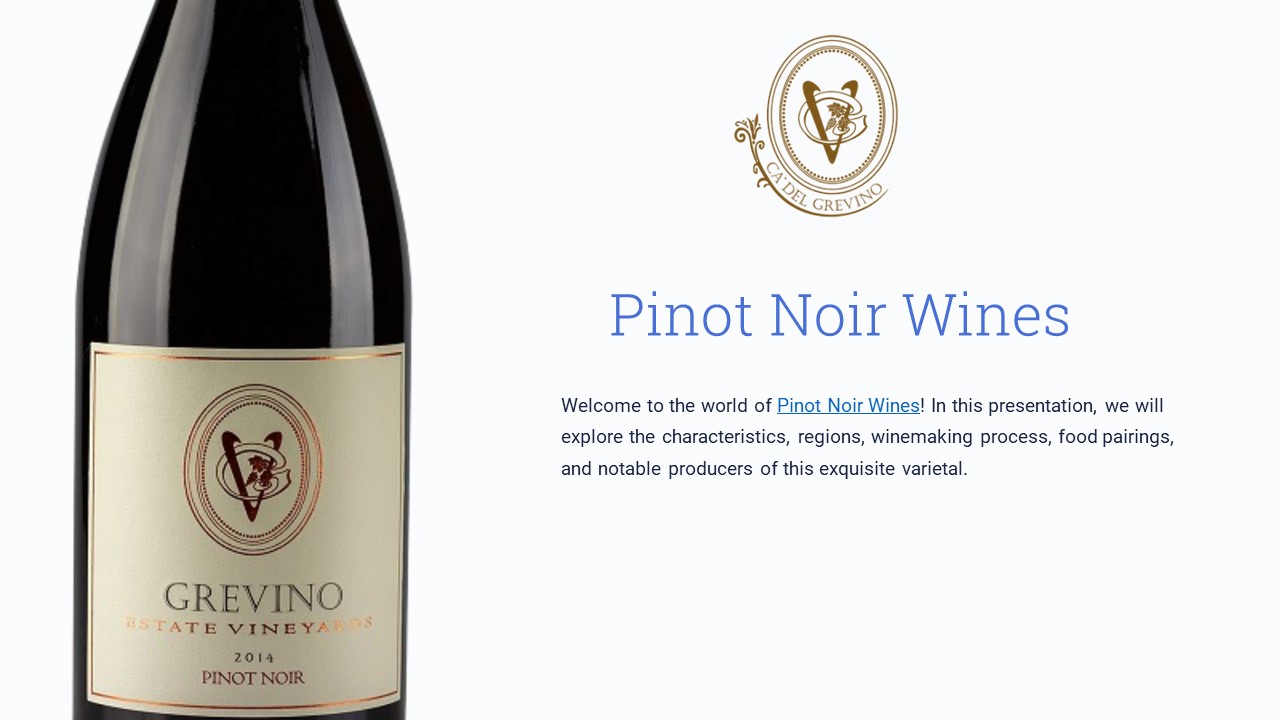Introduction to Pinot Noir Wines - PowerPoint PPT Presentation
Title:
Introduction to Pinot Noir Wines
Description:
Pinot Noir is a red wine grape known for producing elegant and complex wines. It is considered one of the most challenging grapes to grow and make into wine, but the resulting flavors and aromas are worth the effort. – PowerPoint PPT presentation
Number of Views:1
Title: Introduction to Pinot Noir Wines
1
Pinot Noir Wines
Welcome to the world of Pinot Noir Wines! In this
presentation, we will explore the
characteristics, regions, winemaking process,
food pairings, and notable producers of this
exquisite varietal.
2
Introduction to Pinot Noir Wines
Pinot Noir is a red wine grape known for
producing elegant and complex wines. It is
considered one of the most challenging grapes to
grow and make into wine, but the resulting
flavors and aromas are worth the effort.
3
Characteristics of Pinot Noir
1
2
3
Elegant Light-Bodied ??
Complex Nuanced ??
High Acidity Low Tannins ??
Pinot Noir wines are known for their delicate and
silky texture, with flavors ranging from red
fruits like cherries and raspberries to earthy
notes of mushrooms and forest floor.
Pinot Noir wines often have layers of flavors and
aromas, evolving over time. You may find hints of
spices, herbs, flowers, and even subtle notes of
smoke or truffle.
Pinot Noir wines typically have vibrant acidity
and soft tannins, making them approachable and
versatile for pairing with a wide range of foods.
4
Introduction to Pinot Noir Wines
Pinot Noir is a red wine grape known for
producing elegant and complex wines. It is
considered one of the most challenging grapes to
grow and make into wine, but the resulting
flavors and aromas are worth the effort.
5
Winemaking process for Pinot Noir
1
Grapes Harvested
The grapes are hand-picked to ensure the delicate
berries are handled gently and minimize
extraction of harsh tannins.
2
Fermentation Maceration
The grapes are crushed and fermented in open-top
vessels, allowing for more skin contact and
extraction of color, flavor, and tannins.
3
Aging in Oak Barrels
The wine is aged in oak barrels, adding
complexity and subtle oak flavors. The duration
of aging can vary, from months to several years.
4
Bottling Cellaring
After aging, the wine is bottled and may continue
to evolve and develop in the cellar, gaining more
complexity and tertiary aromas over time.































